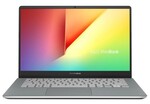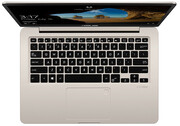Asus VivoBook S14 S433FL
Specifications

Price comparison
Average of 3 scores (from 4 reviews)
Reviews for the Asus VivoBook S14 S433FL
Asus spices up the VivoBook S14 visually and delivers a robust device with various color options. In addition, there are various features, which are partly mutually exclusive. Our review will show what else the VivoBook S14 offers.
Source: Ultrabook Review
 Archive.org version
Archive.org versionFor the most part, the 2020 VivoBooks S14s have outgrown their mid-tier segment, with neat design lines, excellent build quality, competent specs and long battery life, as well as fine inputs and punchy screens. Asus still went with fairly dim panels here, which limit the laptops' usability in brighter environments, and there are a few more quirks you should be aware of, regarding the keyboard/panel options on the lower-end S433FA models, and well as the overall performance of the S433FL variants with Nvidia graphics. We're covering all these in the review down below.
Single Review, online available, Long, Date: 06/05/2020
Rating: Total score: 85%
Foreign Reviews
Source: Inside Handy
 DE→EN Archive.org version
DE→EN Archive.org versionSingle Review, online available, Long, Date: 08/22/2020
Source: 01Net
 FR→EN Archive.org version
FR→EN Archive.org versionSingle Review, online available, Long, Date: 08/31/2020
Rating: Total score: 72% performance: 80% mobility: 80%
Source: Ixbt
 RU→EN Archive.org version
RU→EN Archive.org versionPositive: Compact size; light weight; beautiful design; nice display; high mobility; good hardware. Negative: Only USB 2.0 port.
Single Review, online available, Very Long, Date: 03/25/2020
Comment
NVIDIA GeForce MX250: Successor of the MX150 and still based on the same Pascal GP108 chip (similar to the desktop GT 1030) but with higher clock speeds. Available in two versions, a normal 25 Watt version and a low power version with 10 Watt TDP and reduced performance. The 25 Watt version e.g. offers a 21% higher boost clock than the old MX150 leading to a 5% performance gain.
Modern games should be playable with these graphics cards at low settings and resolutions. Casual gamers may be happy with these cards.
» Further information can be found in our Comparison of Mobile Graphics Cards and the corresponding Benchmark List.
i7-10510U: Comet Lake based low power quad-core processor (technically identical to Whiskey Lake and still produced on 14nm++). The CPU cores can clock between 1.8 and 4.9 GHz (all 4 cores 4.3 GHz max.) with HyperThreading (8 threads). The integrated memory controller supports DDR4-2666 and using cTDP up/down the performance can be adjusted by the OEM (10 - 25 Watt possible, 15W default).» Further information can be found in our Comparison of Mobile Processsors.




